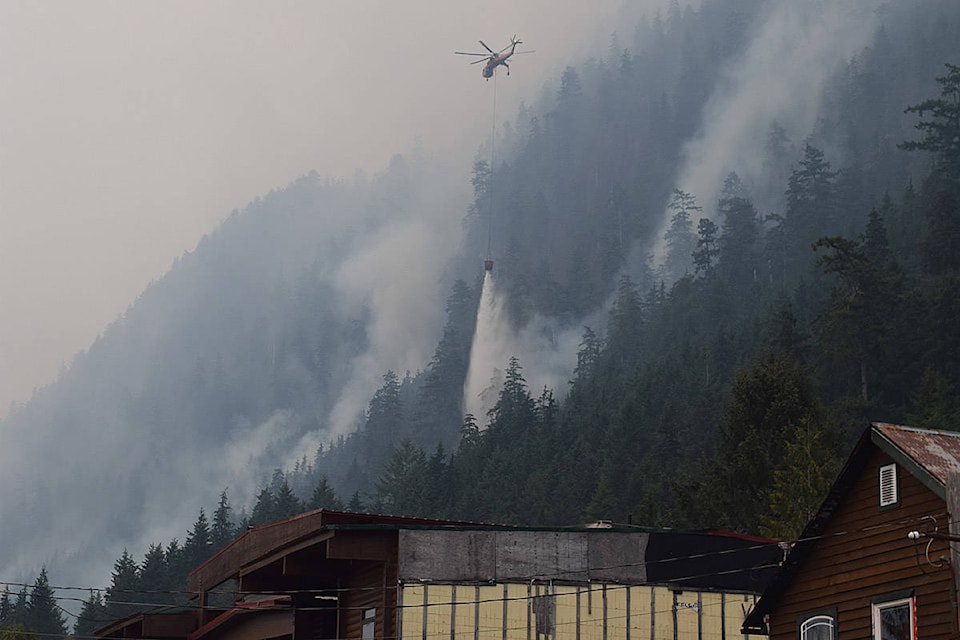Less smoky conditions cleared the way for helicopters in Zeballos on Thursday morning, but forecasts calling for high winds raised concerns about more intense wildfires across the North Island.
“The sky’s nice and clear, so that’s good news because we’re able to fly,” said Lynn Wheeler, an information officer for the BC Wildfire Service.
She said that a rapattack crew – meaning a team of firefighters who rappel from helicopters in areas that are otherwise inaccessible – was planning to land on the bluffs outside of Zeballos to devise a plan.
“They’re assessing today to come up with a plan of attack,” she said.
Information from the rapattack crew will guide a crew of 10 firefighters who are expected to battle the fire’s north flank, she said.
Meanwhile, the BC Wildfire Service was aiming to use air tankers to drop fire retardant along the hydro lines that power Zeballos, Wheeler said. The fire had reached about 1,000 feet from those power lines by Thursday morning.
“Hydro is an issue at all of our main fires,” Wheeler said.
The latest estimate on wildfires at Zeballos put them at 94 hectares in size, compared to 90 hectares on Monday.
The BC Wildfire Service planned to have 26 firefighters on the scene, along with five structural protection unit workers, one piece of heavy equipment and three helicopters.
The town has been under an evacuation alert for over a week, and six homes are under an evacuation order.
The coastal logging village has a population of about 100, while the neighbouring Ehattesaht First Nation reserve is home to 100-150 people.
Meanwhile at Pinder Creek, a wildfire burning directly beside the Zeballos Mainline access road had grown to 220 hectares by Thursday, up from 200 hectares a few days ago.
That fire was 20 per cent contained on Thursday, compared to 10 per cent a few days previous.
Plans on Thursday called for 15 firefighters at Pinder Creek, along with three pieces of heavy equipment and three choppers.
READ MORE: Campbell River store raises cash and supplies for Zeballos emergency workers
READ MORE: On the road to the front lines of the climate crisis
She said firefighters were bucketing the fire, creating firebreaks and laying hose to keep the ground wet.
Wheeler also noted that the fire at Espinose Creek, near the Nuchatlaht First Nation’s Oclucje reserve, remained at 50 hectares in size, with no containment.
There were 15 firefighters slated for that blaze on Thursday, along with one chopper.
Wheeler said 50 km/h winds were expected later in the day, potentially stoking the dozens of wildfire currently burning north of Campbell River, which numbered 64 by Tuesday.
The high wind “is going to increase the fire behaviour on all of our fires,” she said.
The increased intensity could prompt the BC Wildfire Service to remove crews for their safety, Wheeler said.
“We will work the fires as long as we safely can but if it gets too dangerous we’ll be pulling our crews,” she said.
But the outlook for Zeballos was optimistic following concerted efforts by firefighters in the tiny logging town.
“We’re pretty confident about Zeballos,” she said. “We’ve been putting a heck of a lot of water on that fire to cool the edges down near town.”
Meanwhile, levels of fine particulate matter, or PM2.5, which can damage the heart and lungs, decreased as the skies cleared following several days of heavy smoke that hung over Vancouver Island.
In Campbell River, the 24-hour average PM2.5 level was still above the B.C. government’s “acceptable level” of 25 micrograms per cubic metre by late Thursday morning, standing at just under 29 micrograms per cubic metre.
But that’s down considerably from levels that had peaked at more than 163 micrograms per cubic metre on Wednesday.
@davidgordonkoch
david.koch@campbellrivermirror.com
Like us on Facebook and follow us on Twitter
